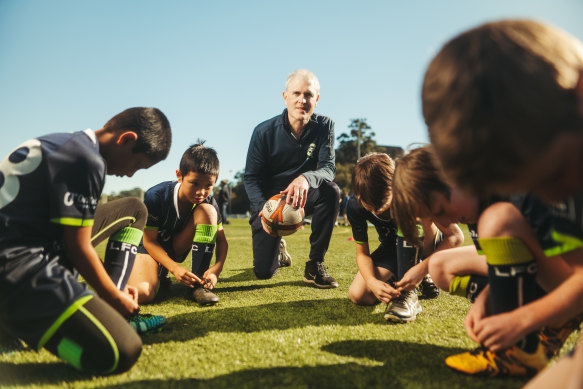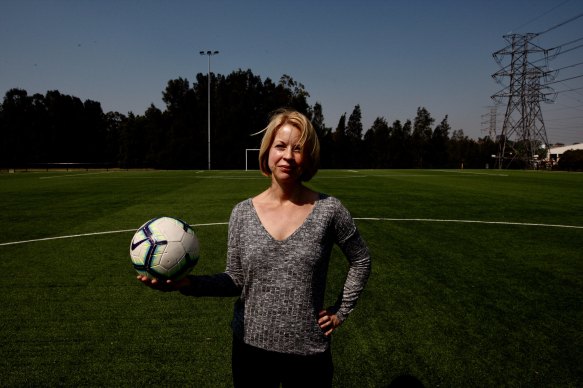This was published 1 year ago
Heading in the right direction: Club brings in experts to prevent head injuries
By Billie Eder
A football club on Sydney’s north shore has taken it upon itself to bring in head injury prevention experts to educate coaching staff on heading the ball in an effort to prevent long-term injuries for players.
Lindfield FC consulted experts in the off-season to provide coaches with information about if and when players should be heading the ball, following decisions to ban the technique for junior players overseas.

Vice president and coaching director of Lindfield Football Club Paul Grundy has brought in experts to educate the club on minimising the damage caused by heading the ball.Credit: Dion Georgopoulos
The club’s decision comes as sporting organisations around the world grapple with the potential long-term effects of head injuries in sports, which could lead to brain diseases such as chronic traumatic encephalopathy.
CTE is a degenerative brain disorder found post-mortem in a number of contact sport athletes, military veterans and others with a history of repetitive brain trauma.
Lindfield FC vice president Paul Grundy said increased awareness and understanding about head injuries in sport encouraged the club to be proactive in their approach to heading.
“As a club, we’re taking a proactive view on heading, but it hasn’t been prompted by concern from parents, it’s been prompted by a broader club concern on health and wellbeing,” Grundy said.
“There’s a shift in coaching more broadly. Less about the player and more about the person. Part of our coaching culture is to be more rounded, and we pride ourselves on trying to lead the community space on some of those things.”

Dr Kerry Peek, a head injury researcher from Sydney University. Credit: Dean Sewell
Dr Kerry Peek, a concussion and head injury researcher at the University of Sydney, engaged with Lindfield FC to help educate coaches.
“I have been doing a fair bit of work with sporting organisations to talk to coaches about the effects of heading and how we should be reducing heading load,” Peek said.
The concern with heading is not concussion, said Peek, but rather the potential accumulative effects of repetitive impacts to the head that come from heading the ball and could lead to CTE in some players.
“The earlier you start, the greater your exposure, therefore the greater risk of these diseases occurring.”
Dr Alan Pearce, the Australian Sports Brain Bank
Dr Alan Pearce, a neuroscientist and researcher from the Australian Sports Brain Bank, said the link between brain diseases and head injuries in sport was better understood now than ever before.
“We know that the risk of CTE and other brain diseases like Alzheimer’s, motor neuron disease, Parkinson’s disease, is related to exposure,” Pearce said.
“It’s not necessarily concussion per se, but rather, it’s repetitive trauma – and the earlier you start, the greater your exposure, therefore the greater risk of these diseases occurring.”
At Lindfield, heading isn’t coached to children under 12, and once they do move into competitive age groups (12-18), they’re taught how to head the ball properly.
“It’s not coached, and nor is it seen in the under-6 to under-11 age groups,” Grundy said.
“Once we get to the competition age groups, heading is a part of the game. As a club, we’re saying, that’s part of the game; we can ignore heading, or we can choose to be proactive about it.
“We need to teach players to head the ball properly. We don’t use a normal football to do that, we have purchased heading balls: they are much lighter, and they are size four not five, so slightly smaller.”
In 2020, the English Football Association (FA) released guidelines for coaches, saying children should not be taught how to head the ball until they are at least 12 years old, and that a “graduated” approach should be taken after that. A player at under-16 level, according to the guidelines, should be exposed to a maximum of 10 headers per week at training.
Football Australia’s national curriculum recommends developing heading skills in the under 14-17 age groups, and using lighter balls when practising headers.
In a statement, Football NSW said they were supportive of heading as a skill in football, and had engaged with experts to produce their current guidelines.
“FNSW has been guided by research in this space conducted in Australia in line with FIFA to encourage the correct education around heading for players and coaches as well as developing tools to strengthen neck muscles to create a stronger foundation for the technique.”
“There are current rules implemented within the MiniRoos age groups (under-6 to Under-11) to minimise heading within the game of football. For example, goal kicks must be thrown or placed on the ground; no drop-kicks or out-of-the-hand punts.”
The Morning Edition newsletter is our guide to the day’s most important and interesting stories, analysis and insights. Sign up here.